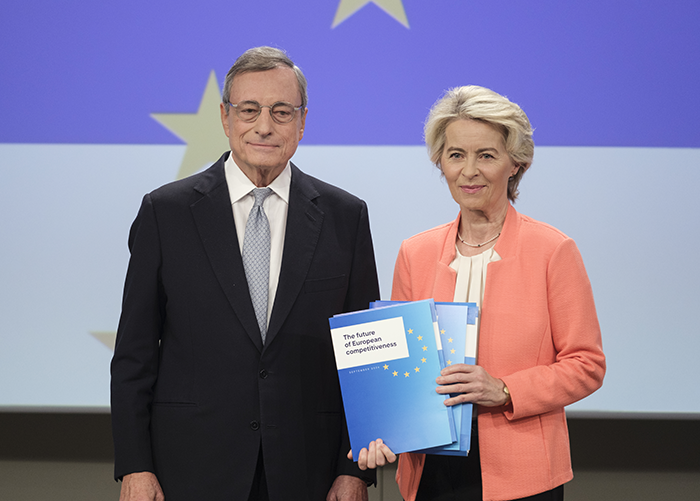Entretiens / Europe, Strategy, Security
23 September 2024
The Draghi Report on the Future of Competitiveness (Or How to Stave off ‘The Slow Agony of the European Union’)

Following on from Enrico Letta’s report on the future of the single market published last April, the report by Mario Draghi, former President of the European Central Bank, on the future of European competitiveness, takes an uncompromising look at the economic situation in the European Union (EU). Referring to the ‘existential challenge’ facing Europe, he proposes an ambitious set of measures aimed at boosting investment and growth, and involving closer cooperation between Member States under the aegis of the European institutions. Pierre Jaillet, associate researcher at IRIS and the Institut Jacques Delors, provides an update.
In this important report, Mario Draghi sounds the alarm about the state of the EU economy. What is his diagnosis?
The data was already known, but the report paints an alarming overall picture of the EU’s ‘falling behind’. Between 2002 and 2023, its gross domestic product (GDP) will have fallen by more than 15% compared to that of the United States, as a result of productivity gains that are three times lower and less dynamic employment. The EU’s share of world trade has been steadily eroding, and its position in the advanced technology sector is waning. Having given priority to productive investment in traditional industries, European companies have missed the turning point in the latest industrial revolution, as illustrated by the fact that only four European firms are among the world’s 50 biggest high-tech companies. But that’s not all. The report highlights the EU’s other handicaps in global competition: very high energy costs (three to four times higher than in the United States, for example); heavy dependence on the outside world for certain ‘critical’ goods (rare minerals, semi-conductors, etc.); a ‘single’ market that is in fact fragmented, not conducive to the emergence of world-class companies; and finally, weak economic governance that is incapable of designing and implementing a coherent and ambitious strategy.
What does the report recommend to stem the EU’s economic decline in the face of competitive pressure from the large blocs dominated by China and the United States?
The report sets out an industrial strategy focused primarily on closing the innovation gap, while optimising decarbonisation efforts (an area where the EU still has a comparative advantage) and securing supplies to limit its strategic vulnerabilities. In this respect, it recommends the introduction of a ‘foreign economicpolicy’ incorporating concerted direct investment and preferential trade agreements with countries or regions that have the resources it lacks (an idea that echoes the Chinese ‘New Silk Roads’ initiative and could be based on the European Gateway project).
La proposition centrale consiste à relever massivement le taux d’investissement annuel de l’UE de près de 5 % pour le porter de 22 % à 27 %, soit un effort de 800 milliards d’euros abondé par trois sources de financement (non réparties ex ante): (1) une hausse des dépenses publiques d’investissement des États membres, dont les marges de manœuvre de la plupart d’entre eux sont réduites du fait de leur endettement élevé et de la nécessité (soulignée dans le rapport) de respecter les règles budgétaires européennes; (2) la mobilisation de l’épargne européenne – abondante mais surtout orientée vers des placements liquides et des supports nationaux – sur des projets d’investissement communs innovants, en réduisant la fragmentation du marché européen des capitaux (Mario Draghi renvoie sur ce sujet aux préconisations du rapport Letta); (3) une nouvelle facilité de financement communautaire alimentée par un emprunt européen (du type de la facilité pour la reprise et la résilience – Next Generation EU (NGEU) – lancée en 2021), qui aurait aussi l’avantage d’offrir un actif sûr et attractif aux investisseurs et accessoirement de conforter le rôle international de l’euro.
S’agissant de la gouvernance, le rapport Draghi avance diverses mesures visant à alléger les procédures de décision de l’UE (revisitant au passage le principe de subsidiarité), qui freinent la mise en œuvre des programmes communautaires. Il propose aussi la création d’un « Cadre de coordination de la compétitivité » ayant une double vocation horizontale et verticale (pilotage d’une douzaine de plans d’action sectoriels dans les domaines prioritaires).
What reactions has this report provoked among EU Member States? Can we expect any decisive changes in Community policies as a result? Is it likely to relaunch the debate on the common debt and budgetary union?
First and foremost, this report has the merit of overcoming the denial of reality regarding the ‘state of the union’. It is also perhaps the first major European document to take a global eco-geopolitical perspective, integrating the dynamics of the balance of power between the major blocs and encouraging the EU to develop strategic alliances – commercial and financial – of mutual interest with countries and regions on other continents. However, the report does not specify how companies that are often competitors can work together to achieve common industrial objectives. Similarly, it leaves in the dark the institutional implications of proposals which, in some cases, would probably require a revision of the Treaties (e.g. the extension of the scope of qualified majority voting, or the sharing of powers between the Member States and the EU in the industrial field). Mario Draghi, who has on several occasions come out in favour of ‘pragmatic federalism’, remains very cautious in this respect and is careful not to call into question the intergovernmental nature of the EU or raise the possibility of a fiscal union.
The ball is now in the court of the European capitals and Brussels, against the backdrop of a very divided Europe. Twenty EU Member States published a non-paper on 20 September calling on the European Commission to implement the Draghi report. The document essentially retains only the proposals relating to the simplification and harmonisation of European rules, ignoring those that are more innovative or more divisive, such as the creation of a new Community facility, a marker of the divergences between ‘frugal’ and ‘spendthrift’ States. We can assume, however, that these are precisely the ones preferred by the seven States missing from the list (including Spain, France and Italy…), without expressing it or having the influence to promote them.
In the end, the major risk is that this ambitious report, against a backdrop of disagreement between Member States and the lack of European leadership capable of putting it on the statute book, will join its predecessors in the drawers or will be implemented at a minimum, leaving the fundamental problems unresolved and Europe sinking into the ‘slow agony’ feared by Mario Draghi.
Translated by Deepl.

